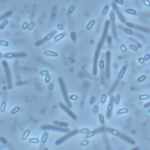Link to Pubmed [PMID] – 19776116
J. Virol. 2009 Dec;83(23):12037-45
Clostridium difficile has been identified as the most important single identifiable cause of nosocomial antibiotic-associated diarrhea and colitis. Virulent strains of C. difficile produce two large protein toxins, toxin A and toxin B, which are involved in pathogenesis. In this study, we examined the effect of lysogeny by PhiCD119 on C. difficile toxin production. Transcriptional analysis demonstrated a decrease in the expression of pathogenicity locus (PaLoc) genes tcdA, tcdB, tcdR, tcdE, and tcdC in PhiCD119 lysogens. During this study we found that repR, a putative repressor gene of PhiCD119, was expressed in C. difficile lysogens and that its product, RepR, could downregulate tcdA::gusA and tcdR::gusA reporter fusions in Escherichia coli. We cloned and purified a recombinant RepR containing a C-terminal six-His tag and documented its binding to the upstream regions of tcdR in C. difficile PaLoc and in repR upstream region in PhiCD119 by gel shift assays. DNA footprinting experiments revealed similarities between the RepR binding sites in tcdR and repR upstream regions. These findings suggest that presence of a CD119-like temperate phage can influence toxin gene regulation in this nosocomially important pathogen.

